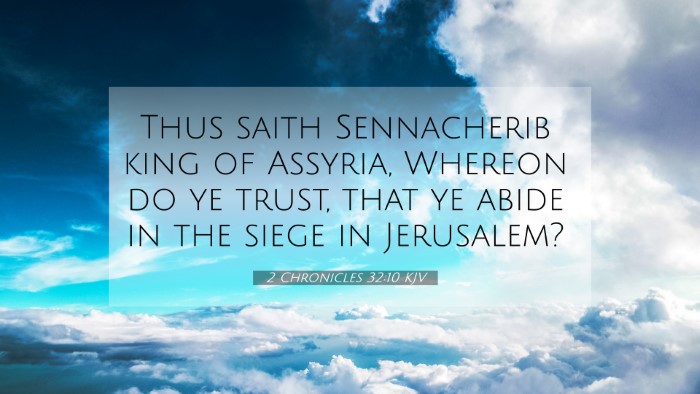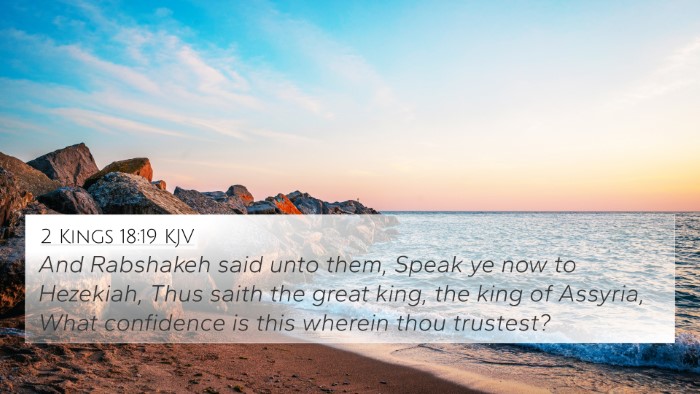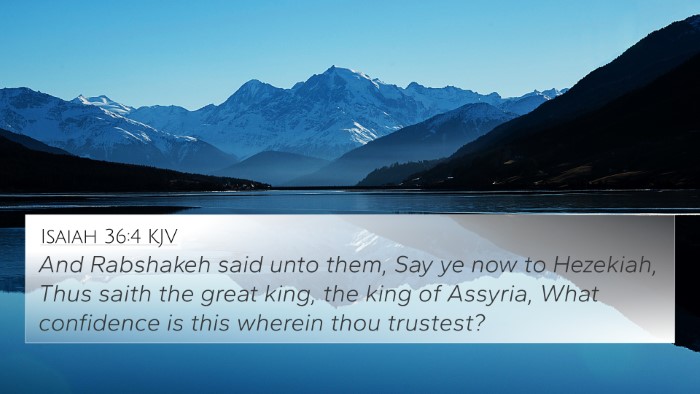Understanding 2 Chronicles 32:10
Verse: "Thus saith Sennacherib king of Assyria, Whereon do ye trust, that ye abide in the siege in Jerusalem?" (2 Chronicles 32:10)
This verse captures a moment of intense confrontation between Sennacherib, the king of Assyria, and the people of Judah during the siege of Jerusalem. The Assyrian king questions the trust of the inhabitants in God's protection, seeking to undermine their faith and resolve.
Commentary Insights
This commentary will draw from various public domain resources to provide a thorough understanding of the context and significance of this verse.
Contextual Analysis
Matthew Henry's Commentary: Henry emphasizes the psychological tactics used by Sennacherib to demoralize the Judeans. His challenge not only reflects a typical wartime strategy of intimidating the enemy but also serves as a means to question the people’s faith in God’s deliverance.
Albert Barnes' Notes: Barnes notes that Sennacherib's statement highlights the desperation of the Assyrians; by attacking the faith of the besieged people, he seeks to weaken their spirit. He points out that facing such threats, the faithful must hold onto their trust in God, despite the overwhelming odds against them.
Adam Clarke's Commentary: Clarke elaborates on the historical context, explaining that the Assyrian empire was at its height, and their military prowess was feared across nations. Sennacherib’s words aim to demonstrate the futility of relying on God, a primary tactic in coercion to force surrender and compliance.
Thematic Connections
This verse opens paths to explore several themes within the scriptural narrative:
- Faith amid Adversity: The verse speaks to the challenge of maintaining faith when faced with overwhelming circumstances.
- Divine Protection: It highlights the assurance of God’s presence during dire situations.
- Spiritual Warfare: The psychological and spiritual struggles manifest in physical confrontations can be seen here.
- Trust vs. Fear: The tension between trusting God and succumbing to fear is a focal point in the narrative.
Cross-References and Biblical Connections
This verse is richly interwoven with other scriptures that reflect similar themes of challenge, faith, and divine intervention:
- Isaiah 36:4-10: A parallel account of Sennacherib’s challenge to Jerusalem, emphasizing the direct confrontation with the very same threats.
- 2 Kings 18:19-22: Further details regarding Sennacherib’s taunts, showing the consistency of his attacks against God’s people.
- Psalms 46:1-3: An assurance of God as a refuge during times of trouble, contrasting the fear instilled by the enemies.
- Romans 8:31: "If God is for us, who can be against us?" affirming the power of faith over fear.
- Proverbs 3:5-6: Encouraging trust in the Lord, this passage highlights the importance of unwavering faith even in the face of adversity.
- Hebrews 11:30: Illustrating the faith of the people of Israel, which ultimately led to their deliverance, reinforcing the message of reliance on God.
- 1 Chronicles 29:11-13: A reminder that God's sovereignty is over all powers, resonating with the trust theme presented in 2 Chronicles 32:10.
Inter-Biblical Dialogue
The verse encourages a deeper investigation of the interconnections between the Old Testament narratives and New Testament teachings. The comparisons reflect how the faith and resilience of believers are timeless themes that echo throughout scripture.
Practical Application
For readers seeking to apply the lessons of 2 Chronicles 32:10 in their lives, consider the following:
- Building Faith: Strengthen your faith through prayer and scripture, especially during trials.
- Community Support: Engage with your faith community to share struggles; together, you can bolster one another's faith.
- Reflection on God's Promise: Recall the stories of God’s deliverance throughout biblical history to reaffirm trust in His protection.
- Facing Challenges: Identify areas where fear is hindering your faith, and actively work to trust in God's provision.
Conclusion
This exploration of 2 Chronicles 32:10 provides a rich tapestry of insights regarding trust in God in adversity. The teachings pull from historical commentary, highlight the need for faith amid fear, and provide a wealth of scripture cross-references to enhance understanding. Embracing these connections can lead to a more profound appreciation of God’s unwavering faithfulness and protection in our lives.
Keywords for Further Study: Bible verse cross-references, Connections between Bible verses, Linking Bible scriptures, Comparative Bible verse analysis, Bible verses that relate to each other, Cross-referencing Biblical texts, Thematic Bible verse connections, Bible verse parallels, Scriptural cross-referencing, Inter-Biblical dialogue.




